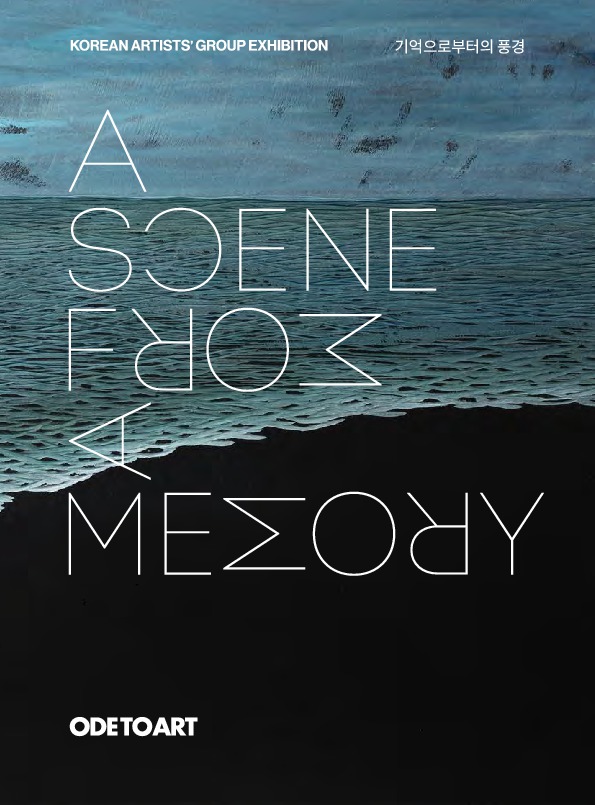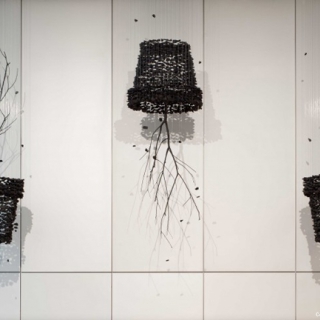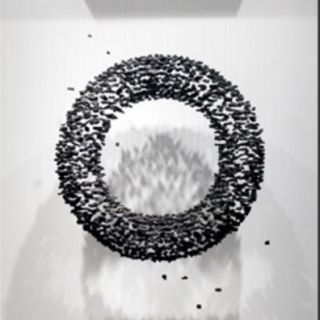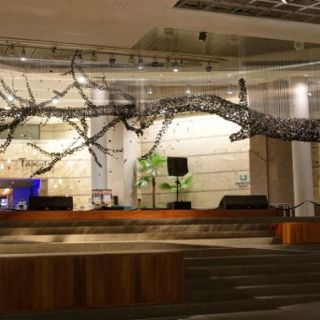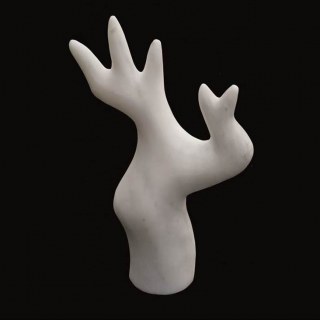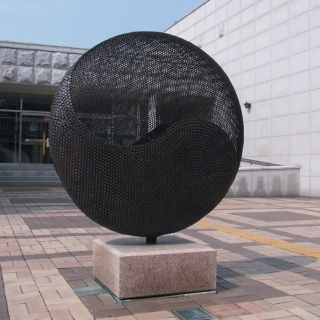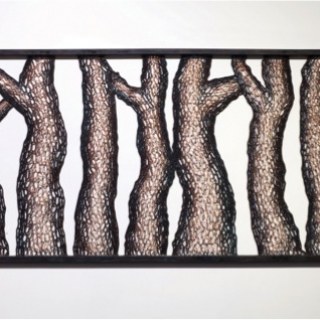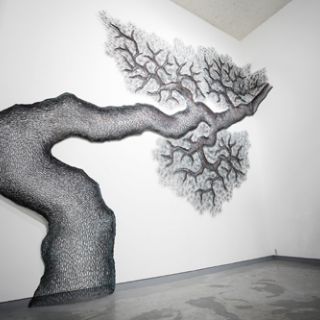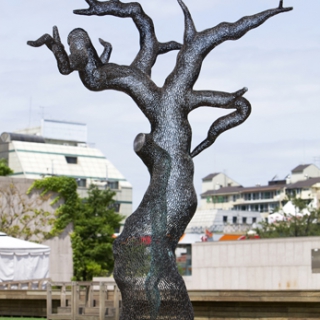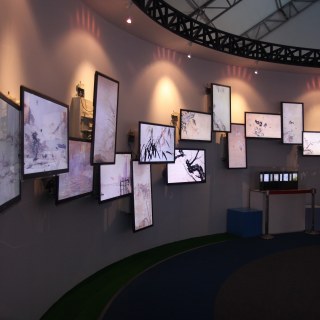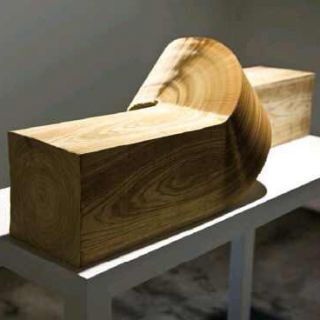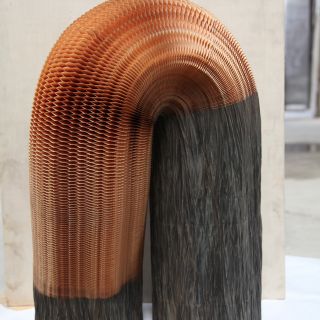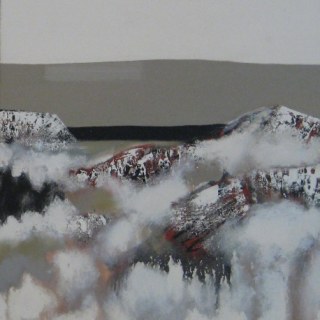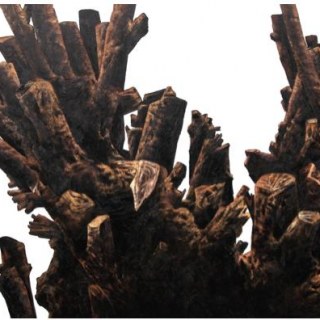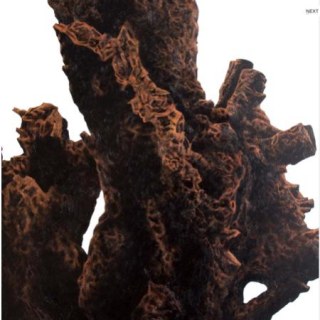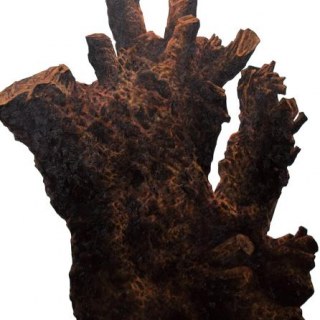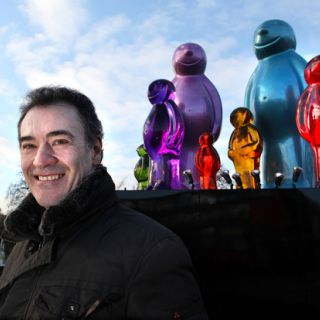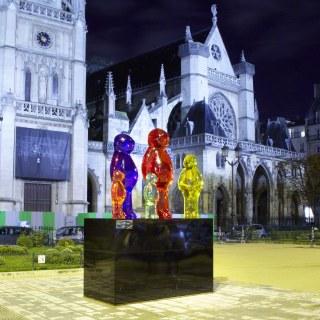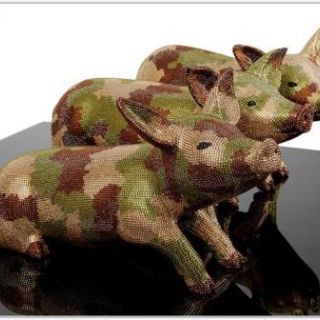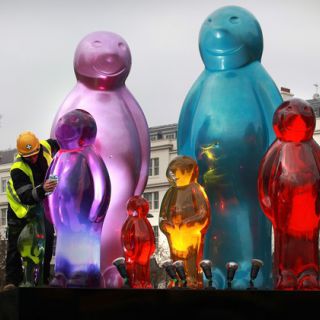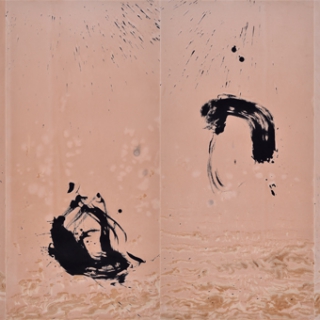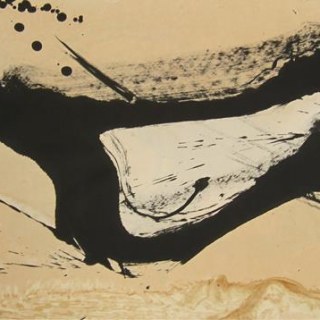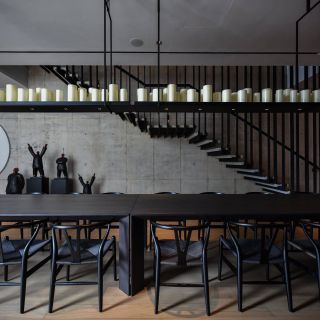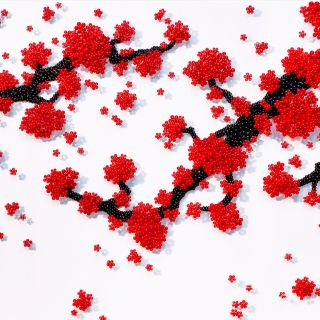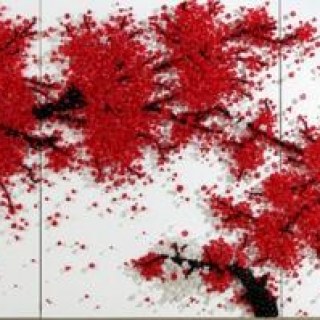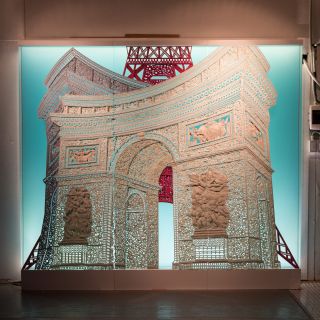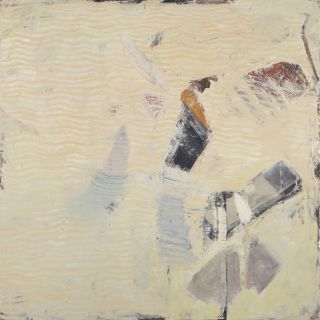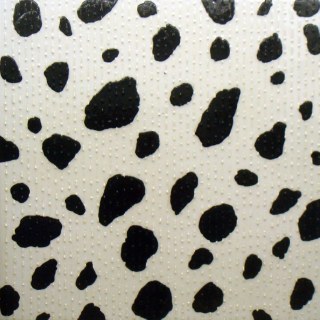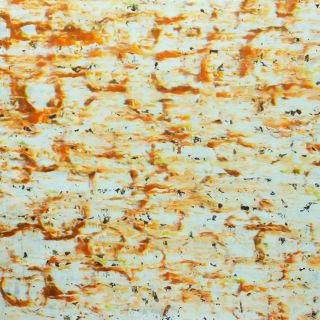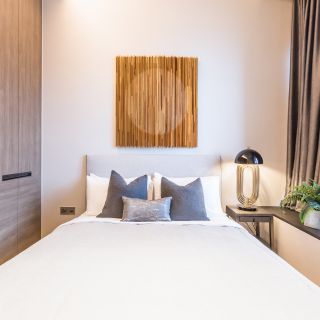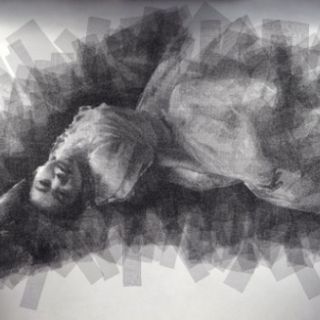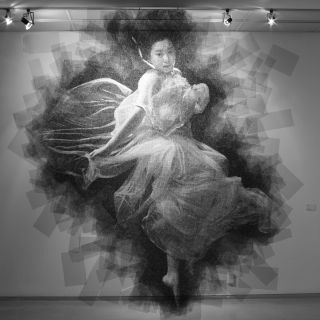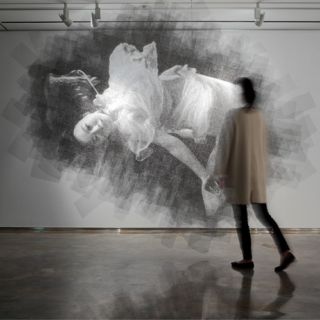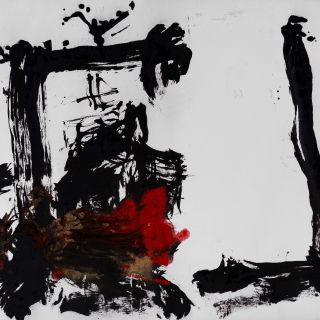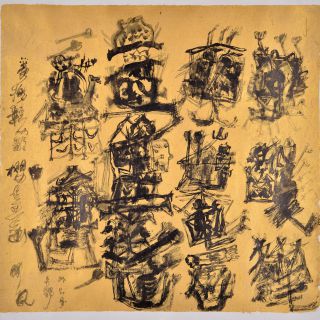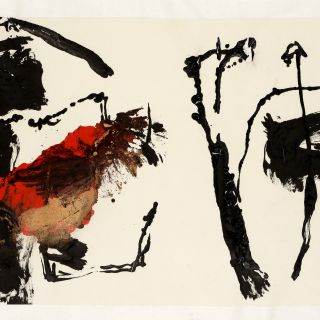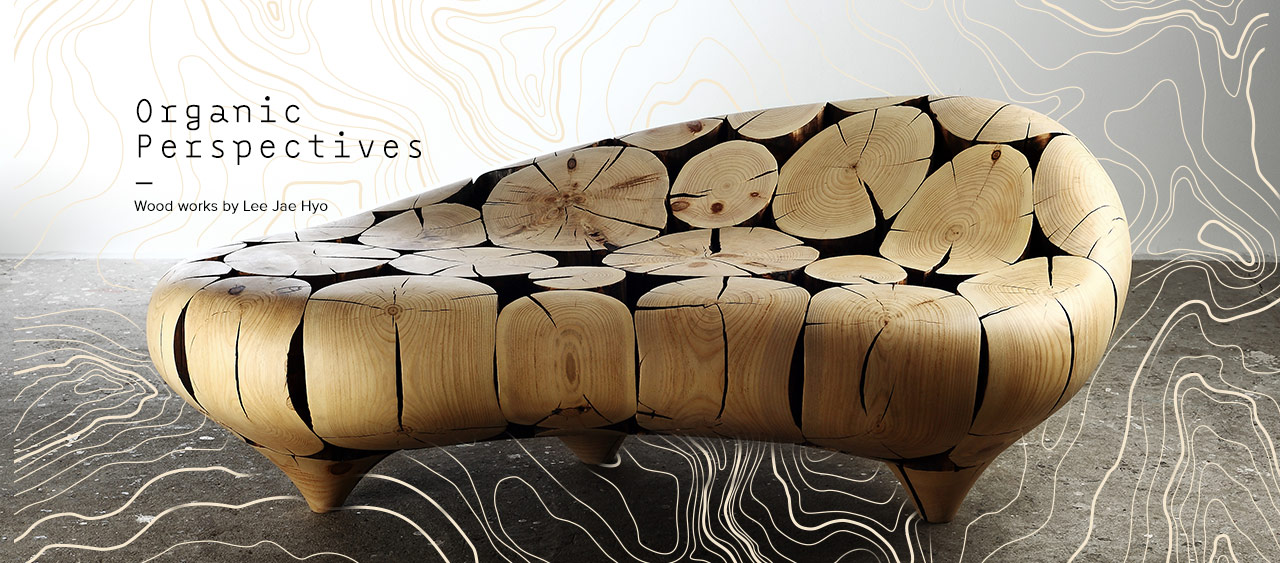
Lee Jae Hyo was born in 1965 in Hapchen, Korea
and graduated from Hong-ik University with a Bachelor Degree in
Plastic Art. He assembles natural materials such as wood pieces, branches and
leaves, or iron nails, into three-dimensional works by which he opens up a
distinctive and innovative direction in contemporary Korean art. He has
exhibited in Korea, Japan, China, the UK
and the USA and has won
a number of honors, including Grand Prize of Osaka Triennial, Young Artist
of the Day presented by the Ministry of Culture of Korea and Prize of Excellence in the 2008
Olympic Landscape Sculpture Contest. His works are widely appreciated and
collected in Asia, Europe and America.
Viewing 4 works by Lee Jae Hyo
Sort
Videos 
Videos

"A Scene from A Memory: A Group Exhibition" featuring 16 Korean Artists at Ode to Art Contemporary
Various Artists
Biography 
Biography
Lee Jae Hyo was born in 1965 in Hapchen, Korea, and produces immaculately formed, intricate sculptures that reveal a mastery of his materials.. He graduated from Hong-ik University with a Bachelor Degree in Plastic Art, and has been creating wood masterpieces since the 1990s. He assembles natural materials such as wood pieces, branches and leaves, and iron nails into three-dimensional works which not only hold elegant forms but also convey a strong contemporary mood.
The subject of nature is central to the art of Lee Jae Hyo. "I have great respect for nature. My works are inspired by it. I collect logs in forests, the stones come from the riverbed. To choose one or the other already determined the work to come," says Lee. The energy of nature, the uncluttered lines, the simplicity of its elements, shapes his works, and his creative concern is "to discover a different way to present common materials." Revealing a subtly humorous and unsentimental attitude to nature, what unites these works is a belief that the beauty of art is a product of the labor from whence it comes, whether this be the meticulous carving of larch trunks into the form of a perfect sphere or, equally, the precise bending and sanding of thousands of nails hammered one after another into a hunk of cut lumber.
Lee has held many solo exhibitions in Korea, Japan, China, the United Kingdom and the United States. He won a number of honors, including Grand Prize of Osaka Triennial (1998), Young Artist of the Day presented by the Ministry of Culture of Korea (1998) and Prize of Excellence in the 2008 Olympic Landscape Sculpture Contest. His works are widely appreciated and adored by art collectors all over Asia, Europe and America.
Collections
Crown Hotel
Australia Park Hyatt Hotel Zurich
Switzerland Grand Hyatt Hotel Berlin
Germany President Wilson Hotel
Switzerland Marriott Hotel
Korea Cornell University
USA National Museum of Contemporary Art
Korea Moran Museum
Korea W-Seoul Walker-hill Hotel
Korea MGM Hotel, USA
Intercontinental Hotel, Switzerland
Awards
2008
Prize of Excellence of 2008 Olympic Landscape Sculpture Contest
2005
Prize of Excellence of Hyogo International Competition of Painting
2002
Sculpture in Woodland Award
2000
Kim Sae-Jung Young Artist Prize
1998
Grand Prize Winner of Osaka Triennial
The subject of nature is central to the art of Lee Jae Hyo. "I have great respect for nature. My works are inspired by it. I collect logs in forests, the stones come from the riverbed. To choose one or the other already determined the work to come," says Lee. The energy of nature, the uncluttered lines, the simplicity of its elements, shapes his works, and his creative concern is "to discover a different way to present common materials." Revealing a subtly humorous and unsentimental attitude to nature, what unites these works is a belief that the beauty of art is a product of the labor from whence it comes, whether this be the meticulous carving of larch trunks into the form of a perfect sphere or, equally, the precise bending and sanding of thousands of nails hammered one after another into a hunk of cut lumber.
Lee has held many solo exhibitions in Korea, Japan, China, the United Kingdom and the United States. He won a number of honors, including Grand Prize of Osaka Triennial (1998), Young Artist of the Day presented by the Ministry of Culture of Korea (1998) and Prize of Excellence in the 2008 Olympic Landscape Sculpture Contest. His works are widely appreciated and adored by art collectors all over Asia, Europe and America.
Collections
Crown Hotel
Australia Park Hyatt Hotel Zurich
Switzerland Grand Hyatt Hotel Berlin
Germany President Wilson Hotel
Switzerland Marriott Hotel
Korea Cornell University
USA National Museum of Contemporary Art
Korea Moran Museum
Korea W-Seoul Walker-hill Hotel
Korea MGM Hotel, USA
Intercontinental Hotel, Switzerland
Awards
2008
Prize of Excellence of 2008 Olympic Landscape Sculpture Contest
2005
Prize of Excellence of Hyogo International Competition of Painting
2002
Sculpture in Woodland Award
2000
Kim Sae-Jung Young Artist Prize
1998
Grand Prize Winner of Osaka Triennial
Exhibitions 
Exhibitions
2010
Albemarle Gallery London
Kwai Fung Gallery, Hong Kong
REEVES Contemporary, New York
2009
Gallery Sol Beach, Korea
Ever Harvest Art Gallery,Taiwan
Gallery Keumsan, Japan
Albemarle Gallery London
2008
MANAS Art Center, Korea
BUNDO Gallery, Korea
DOSI Gallery, Korea
REEVES Contemporary, New York
2007
Gallery Keumsan, Japan
Gallery Artside, China
Gallery Keumsan, Korea
2006
Gallery Marin, Korea
2005
Gallery Artside, Korea
2003
Gallery Won, Korea
2001
Vermont Studio Center, USA
2000
Ilmin Museum of Art, Korea
Albemarle Gallery London
Kwai Fung Gallery, Hong Kong
REEVES Contemporary, New York
2009
Gallery Sol Beach, Korea
Ever Harvest Art Gallery,Taiwan
Gallery Keumsan, Japan
Albemarle Gallery London
2008
MANAS Art Center, Korea
BUNDO Gallery, Korea
DOSI Gallery, Korea
REEVES Contemporary, New York
2007
Gallery Keumsan, Japan
Gallery Artside, China
Gallery Keumsan, Korea
2006
Gallery Marin, Korea
2005
Gallery Artside, Korea
2003
Gallery Won, Korea
2001
Vermont Studio Center, USA
2000
Ilmin Museum of Art, Korea
Critique 
Critique
Korean contemporary art has for some decades now revealed a very special sensibility - neither Chinese nor Japanese, but containing elements reminiscent of both. Lee Jae Hyo's work shows immense respect for natural materials, but also the will to dominate what nature has provided. One is immediately struck by the perfection of his craftsmanship, and led to reflect on the many long hours of hard physical labour that must have gone into the production of these immaculate, yet also intricate objects.
If one knows something about what he has produced previously, one also notes that he is no longer content to produce only quasi-geometric or, alternatively, biomorphic shapes. Many of the sculptures here are also furniture - couches, a chair, a table, a large dish. This development is in step with something that is happening in the art world in general. Fine arts and so-called applied arts, have maintained a respectful, if in some cases also a rather disdainful distance for years. In the West, this is an occurrence that has happened for centuries but the two areas are slowly beginning to come together again. Lee possesses a quality that is usually associated with artists from the Far East - a sly, sophisticated wit. These are domestic items that, for me at least, have an element of parody. Just as Ancient Greek sculpture idealizes the human body, Lee Jae Hyo, tongue-in-cheek, idealizes the image of the chaise longue.
There are several things one can say about this. The first is that the items we encounter in our daily lives, and perhaps most intensely those that we encounter in our own domestic surroundings, have formal qualities that can be thought of in ways quite detached from their actual utility. A sofa is a shape, and that shape can be analysed in terms of visual relationships, not merely in terms of what it feels like to sit on it.
A second observation is that Lee Jaehyo is, in addition, what one might describe as an analyst of luxury. Anyone who encounters his work must immediately be struck by the beauty, and also by the tactility of his surfaces. Yet these surfaces are a direct expression of the qualities of very humble materials.They expose the inner nature of these materials, often in a very literal sense - in the way, for example, that the sculptures made entirely of wood make play with the patterns of tree rings.
The world of western crafts, and especially that part of it that descends directly from the Arts and Crafts movement of the late 19th century, has never been able to feel much affection for things that seem to relate too directly to the world of industry. Lee Jaehyo has no such inhibitions. Stainless steel bolts and nails are part of his palette. These metal items are set into burned wood and then polished flat. They offer a myriad of small light reflecting forms against a dark surface. The effects he achieves with this technique are extremely varied. Sometimes the patterns look like star maps. Sometimes they look like rippling water. Sometimes they look like spermatozoa seen through a microscope. And sometimes they look like seedlings competing for space and air.
The references are not always to nature. Some of his most intriguing works in this category make use of the forms of the western alphabet, all jumbled together. There is an almost irresistible urge to scan them for meaning, to see if one can make out some kind of coded message.
There is a message in what he does, but not one that can be read in any literal sense. Lee Jae Hyo forms his materials. He respects their inherent qualities but also dominates them, both by force of skill and force of will. In doing so, he initiates a dialogue, both with them and with us as spectators. He also does something else, which is comparatively rare in the world of contemporary art. He is, in several senses, a playful artist. He is playful in the sense that he likes to juggle with materials, and see what they can be made to do. He is so fully in command of his skills that there is, paradoxically, no sense of the laborious.
He is also playful in a different way. He sees the world in a slightly oblique way and has a gift for turning the familiar into the unfamiliar. Almost all of us, at one time or another, have had the experience - perhaps when we have just woken up - of feeling completely disassociated from things that, at other moments, are perfectly familiar to us. A chair is not a chair. A table is not a table. It is, instead, a wholly alien object forcefully imported into an entirely unready consciousness. What Lee Jae Hyo offers, in fact, are opportunities for seeing the world anew, with the kind of innocence of vision that we associate with child's play.
Edward Lucie-Smith
Art Historian, Critic and Writer
If one knows something about what he has produced previously, one also notes that he is no longer content to produce only quasi-geometric or, alternatively, biomorphic shapes. Many of the sculptures here are also furniture - couches, a chair, a table, a large dish. This development is in step with something that is happening in the art world in general. Fine arts and so-called applied arts, have maintained a respectful, if in some cases also a rather disdainful distance for years. In the West, this is an occurrence that has happened for centuries but the two areas are slowly beginning to come together again. Lee possesses a quality that is usually associated with artists from the Far East - a sly, sophisticated wit. These are domestic items that, for me at least, have an element of parody. Just as Ancient Greek sculpture idealizes the human body, Lee Jae Hyo, tongue-in-cheek, idealizes the image of the chaise longue.
There are several things one can say about this. The first is that the items we encounter in our daily lives, and perhaps most intensely those that we encounter in our own domestic surroundings, have formal qualities that can be thought of in ways quite detached from their actual utility. A sofa is a shape, and that shape can be analysed in terms of visual relationships, not merely in terms of what it feels like to sit on it.
A second observation is that Lee Jaehyo is, in addition, what one might describe as an analyst of luxury. Anyone who encounters his work must immediately be struck by the beauty, and also by the tactility of his surfaces. Yet these surfaces are a direct expression of the qualities of very humble materials.They expose the inner nature of these materials, often in a very literal sense - in the way, for example, that the sculptures made entirely of wood make play with the patterns of tree rings.
The world of western crafts, and especially that part of it that descends directly from the Arts and Crafts movement of the late 19th century, has never been able to feel much affection for things that seem to relate too directly to the world of industry. Lee Jaehyo has no such inhibitions. Stainless steel bolts and nails are part of his palette. These metal items are set into burned wood and then polished flat. They offer a myriad of small light reflecting forms against a dark surface. The effects he achieves with this technique are extremely varied. Sometimes the patterns look like star maps. Sometimes they look like rippling water. Sometimes they look like spermatozoa seen through a microscope. And sometimes they look like seedlings competing for space and air.
The references are not always to nature. Some of his most intriguing works in this category make use of the forms of the western alphabet, all jumbled together. There is an almost irresistible urge to scan them for meaning, to see if one can make out some kind of coded message.
There is a message in what he does, but not one that can be read in any literal sense. Lee Jae Hyo forms his materials. He respects their inherent qualities but also dominates them, both by force of skill and force of will. In doing so, he initiates a dialogue, both with them and with us as spectators. He also does something else, which is comparatively rare in the world of contemporary art. He is, in several senses, a playful artist. He is playful in the sense that he likes to juggle with materials, and see what they can be made to do. He is so fully in command of his skills that there is, paradoxically, no sense of the laborious.
He is also playful in a different way. He sees the world in a slightly oblique way and has a gift for turning the familiar into the unfamiliar. Almost all of us, at one time or another, have had the experience - perhaps when we have just woken up - of feeling completely disassociated from things that, at other moments, are perfectly familiar to us. A chair is not a chair. A table is not a table. It is, instead, a wholly alien object forcefully imported into an entirely unready consciousness. What Lee Jae Hyo offers, in fact, are opportunities for seeing the world anew, with the kind of innocence of vision that we associate with child's play.
Edward Lucie-Smith
Art Historian, Critic and Writer

Stay connected.
Sign up to our newsletter for updates on new arrivals and exhibitions



